Basque Coast (IV): Beaches
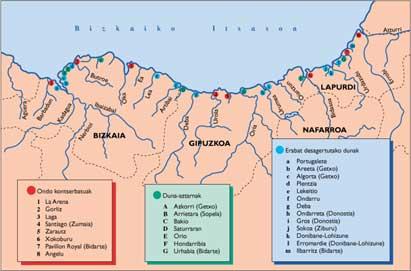
For most cases, beaches are an ideal place to increase the melanin rate of skin cells, which allows to show a good tan, but from a geological and ecological point of view, these geomorphological elements of the coast are places of great attraction.
However, the enormous increase in human pressure that the coast has known in recent decades has caused great changes in our beaches and in general in the morphology of the entire coast, due to the current plight. But let us analyze all these aspects more slowly.
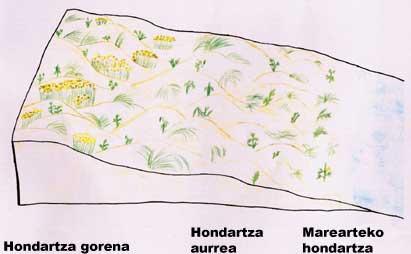
Beach training
Since the formation of beaches is a process associated with erosive phenomena on the coast, mention of these phenomena is essential to better understand the origin of beaches.
These erosive phenomena have two phases: erosive and constructive. Eroding occurs especially in stormy times. Then, when the sea waves burst violently against the cliffs, they throw stones and bowling at the cliff rocks. As a result, the cliff falls and these detached pieces of rock undergo a more severe erosion process when colliding with each other due to the strength of the drawer.
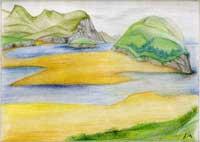
The particles generated in this erosive process form sedimentation processes during offshore days. This is the constructive phase. The lighter particles are dragged by the sea and applied on the continental shelf, accumulating silts in these shallow areas. The sand and gravel remain on the coast forming beaches at the base of the cliffs and at the mouth of the rivers.
Types of beaches
According to the geomorphological district in which they appear, the beaches of our coast can be divided into three large groups:
- On the one hand, at the base of the cliffs we find narrow and usually small beaches, open to the sea. Its origin would be the sedimentation of sand or gravel in the intertidal cracks that are formed in the bases of the cliffs due to the erosion of the sea. Its location makes them beaches difficult to access. These are the beaches of Akotz in Getxo, Azkorri, Itzurun in Zumaia and San Juan de Luz.
- On the other hand, we have the beaches located at the mouth of the rivers. In this case it is necessary to mention that the origin of the sand is double, to the obtained as a result of the erosion of the cliffs, due to the erosion caused by the rivers in their banks, it is necessary to add the one that pass to the water and by this it is transported to the mouth. They are of this type the sand bars and the sand that usually appear in all our coasts. For example, the beach of Hendaia or the one that used to be seen in Portugalete and Las Arenas.
- Finally, it is worth mentioning the inland bays so scarce on our shores. In the bays, due to the loss of energy of the marine crate, ideal conditions for sedimentation meet, a sedimentation that creates wonderful beaches of half circle. In the bays you can also find the fourth beach called tombolo. They are tombolos, lands that had formerly been islands and sand conflicts that unite the continent. Sedimentation inside, typical of the rías and bays, occurs when it occurs in the back of an island. The clearest example is that of Urgule de Donostia. The old town of the capital of Guipuzcoa and all the widening have been built on this tombolo.
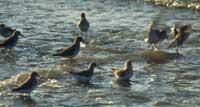 During migration large groups of birds are observed on the beaches. Common timbres.J. Terés
During migration large groups of birds are observed on the beaches. Common timbres.J. Terés
Stretches of beaches
Due to its composition by sandy sediments, the morphology of the beaches is very variable due to the high influence of wind and sea. However, normally the beaches are divided into four parts or areas:
- By the beach: area that remains always under water, except in dead tides.
- Intertidal beach: area between high tide and low tide. Also known as clay beach.
- Beachfront: flooded area only in live tides or days of great sea storm. This area, both by the flow of the sea and by human waste, concentrates a large amount of organic matter.
- Maximum beach: it is the area that is never covered with water. In these areas,
inland, if the sea level remains low on large surfaces, dunes
usually appear. On the one hand, the mountains of premature sand between the beach and the dunes, usually due to the great mobility of the sand, are of low height and last a short time and, on the other hand, the true dunes that appear further back. In them the salinity of the atmosphere is null and, in addition to having greater height and size of the meniscas, they have variable shapes and slopes.
Vegetation
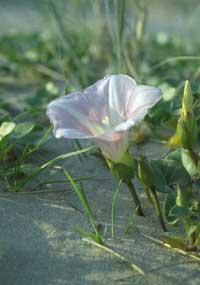
On the beaches, despite the harsh living conditions, there are numerous plant species adapted to live on the highest beaches and, to a lesser extent, facing the beach.
The species of this dune vegetation, known as psammofifila vegetation, have a great ecological value, since throughout evolution they have acquired special adaptations for survival in these harsh environments. And what are these harsh living conditions?
- On the one hand, they are areas of strong wind, which not only prevents the presence of high altitude plants, but the grains of sand transported by the wind produce erosion in plant tissues.
- On the other hand, due to the rapid fluidity of rainwater through numerous stretches between accumulated sand grains and their presence in solar boilers, the surface layer dries immediately.
- Another factor to consider is the salinity of the atmosphere, since the salinity is high and the plant suffers from osmosis problems (tends to extract water from the cells to compensate for the difference of external/internal salinity).
- Finally, it should be noted that the great mobility of the sand of the dunes makes the soterramientos and abrupt outcrops very common.
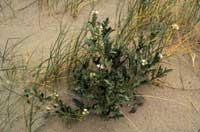
To address all these problems, the psammophilic plant species (dune vegetables) have acquired different and striking adaptations. Highlights:
- The scarcity of water on the surface of the dunes, obtained from the lower layers, allows to remain fixed in this unstable substratum, thanks to the presence of numerous plant species with root systems of great development. Among the plant species of the adapted dunes are the grasses Ammophila arenaria or Carex arenaria.
- To curb the tendency of plants to lose water in cells due to high atmospheric salinity, several dune plant species have developed fatty tissues. Thanks to these special fabrics, they not only overcome osmosis problems, but also face the aridity of the earth, as they manage to take advantage of the salty moisture of the atmosphere. The clearest examples of this adaptation are Honckenya peploides and Cakile maritima.
- Some species have abundant hair on leaves and trunks. Thanks to them they manage to reflect the solar rays that could burn plant tissues, reduce perspiration (amount of water that return plants to the atmosphere) and retain raindrops on leaves. In the dunes of the Basque Country, the herbaceous species Medicago marina is one of the examples of this characteristic.
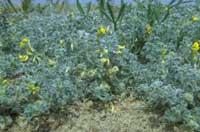 Marina Medicago. Thanks to its hairs it reflects the rays of the Sun.M. Estonba
Marina Medicago. Thanks to its hairs it reflects the rays of the Sun.M. Estonba - Finally, to avoid continuous burials and outcrops, some dune plants have developed different adaptations. There are species of the genus Elymus such as the cimbele stems, while Pancratium maritimum has bulbs (subterranean buds transformed to store reserves) and the Aetheorriza breast has tubers (stem thicknesses rich in reserve substances).
However, these environmental factors do not have the same incidence on the entire surface of the dune, as different ecological gradients are generated from sea to land. As a result, psammófila plants are distributed in different sections, on beaches where human influence has not been very high.
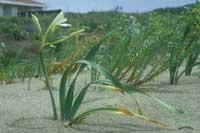
Facing the beach, despite the humidity and salinity, and the amount of organic matter dragged by the sea and man, you can find annual plants such as Cakile maritima, Salsola kali, Poligonum maritimum, etc. All belong to the Honkenyo-Euphorbietum peplis association.
Further back, where the sand begins to accumulate and where the wind often changes the shape and place of the residual mountains, is a plantation of plants of little extension. The most common plant species in these areas are Elymus farctus, Euphorbia paralias, Calystegia soldanella or Eryngium maritimum, from the association Euphorbio-Agropyretum junceiformis.
Behind there are authentic dunes. Its size and height is larger and, usually, its plant extension is larger and more rooted. In this area where the influence of salinity is null, along with the gramineous Ammophila arenaria of the association Otantho-ammophyletum australis, are plant species such as Lagurus ovatus, Pancratium maritimum, Leontodon saxatalis arenaria.
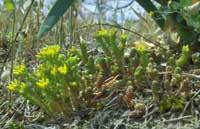
Finally, as the influence of the sea decreases and the wind and soil are rooted, the diversity and extent of the plants increases and in some cases are formed soropillitos composed by Carex arenaria, Festuca rubra arenaria, Helichrysum stoechas, Koelaria glauca, etc. These species constitute the association Kolerio albescentis-Helichrysetum stoechis.
However, the situation of this type of vegetation is not good. In recent years, due to the strong aggressions suffered by these areas, 35% of native plant species are in danger of extinction in the Basque Country and the remaining 35% are declared as rare plant species in the plant catalog of Álava, Gipuzkoa and Bizkaia.
Wildlife
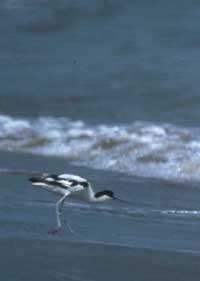
As for the fauna, we can differentiate two areas on the beaches, the first of them formed by the interior of the beaches and the intertidal, and the second by the facade and the highest beach.
In the former, populations of molluscs, polychaetes and filterers of low-density crustaceans predominate. In the second, however, there is a great wealth in excavated insects, most of them of order Coleoptera, Diptera and Hemipte. In this second case, populations of gasteropod species such as Theba pisana, Cernuella virgata, Cochliella barbara, C. acuta, etc. are also very important.
It should be noted that, especially in summer, to combat the extreme heat of the soil, all these animals rise to the dune plants. Thanks to this, at this time you can see large concentrations of gasteropods in plants.
It seems that the regularization of beaches along with a great human impact has been a fertilizer for these populations of molluscs, since the scarcity of proteins in these areas of open and living structure is a limiting factor.
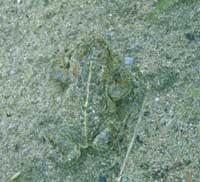
As for vertebrates, although until recently were in the dunes stable populations of reptiles, amphibians and birds, due to the drastic changes that have suffered our beaches in recent years, these populations have practically disappeared. In amphibians, the runner toad (Bufo calamita) is the most typical species of these areas, while in reptiles the lizard wall (Podarcis muralis) would be its main representative.
In the case of birds, the usual visitors to the beaches are migratory species. So it is, in times of migration and especially in days of strong storm (the days when the human presence is more scarce) limicolo is usually normal (timbres, brandados, kurlintas, etc. ), the gull (Larus sp. and Rissa sp. ), chenada (Sterna sp. ), bring large groups of marine swallows and other species of birds to our beaches in search of rest and food.
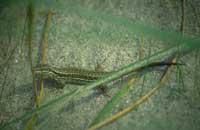
In the dunes, however, despite the greater abundance of birds during the migratory season, we can find different species of birds throughout the year, such as chips (Anthus sp. ), clayey (Motacilla sp. ), tweets (Phylloscopus sp. ), cholares (Passer sp. ), clays (Oenanthe sp. ), etc.
Buletina
Bidali zure helbide elektronikoa eta jaso asteroko buletina zure sarrera-ontzian











